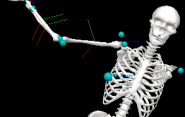More Than Just Strikeouts, Throwing Fast Gave Us The Ability To Evolve

Regardless of how your team fared this first week of the baseball season, you can always marvel at the astounding evolution of human biomechanics that made throwing possible.
 The physiological features that allow a pitcher to deliver a baseball from mound to home plate gave us more than just a good fastball. Prof. Madhusudhan Venkadesan, who studies the biomechanics and control of animal movement, explains that they also gave us the ability to hunt, eat meat, grow large brains and evolve into who we are today.
The physiological features that allow a pitcher to deliver a baseball from mound to home plate gave us more than just a good fastball. Prof. Madhusudhan Venkadesan, who studies the biomechanics and control of animal movement, explains that they also gave us the ability to hunt, eat meat, grow large brains and evolve into who we are today.
Venkadesan, who teaches mechanical engineering and materials science, has studied images of baseball players captured with 3D cameras and built devices in his lab to replicate throwing motions. With a team of researchers, he has published studies on throwing, and has more in the works.
One of the first questions they looked at is how we throw at such high speeds. And here, we're not talking about just baseball players; humans in general are the throwing aces of the animal kingdom. Chimpanzees throw, but no better than a small child.
When we throw an object, the arm undergoes angular velocities of more than 9,000 degrees per second – that's the fastest movement in the human body. But after he and the other researchers did some calculations, Venkadesan said they knew it couldn't be the upper-body muscles alone that produce this kind of power.
"What happens is that the power is generated down by your hip and waist, where we have huge muscles," he said. That the waist can rotate is crucial to throwing, since it allows the body to store elastic energy, which occurs when objects are stretched or compressed. "The goal of throwing is to transmit that power, from the waist, out to your hand. We do that by storing and releasing elastic energy in the shoulder. That is what we think is happening."
Another big part of our throwing ability comes from what's known as the glenoid joint, the collarbone-and-socket combination in the shoulder. This joint points upward in chimps, which makes it look like they're always shrugging their shoulders. In humans, it's lateral, which allows us to turn the arm into a huge lever powered by the elastic energy stored in the tendons and ligaments across the chest and shoulder muscles – like giant rubber bands.
The last component of this system is the twisted geometry of the humerus, the bone that runs from shoulder to elbow. The twist in the bone allows throwers to rotate the arm far back to increase the stored elastic energy.
These three factors – the mobile waist, the sideways glenoid joint and the twist in the humerus – first appear together in the fossil record about 1.8 million years ago in homo erectus. That's just around the time when there's strong evidence of hunting. The throwing-hunting connection makes sense. Humans, who specialize in long-distance running could chase down large animals until they were exhausted. But then what?
"You really don't want to be within an arm's reach of the animal," Venkadesan says, adding that just one kick from the animal would bring an abrupt end to the hunt. "What you want to do is fling a rock or something hard really fast to kill the animal."
While Venkadesan's research answers a lot of questions about throwing, he said there are still more that need to be addressed – and which his lab is currently working on. For instance, how do we throw so accurately at high speeds? And why do we throw overhanded?
"Of all the possible ways someone could throw, why is this the best way?" he said.

